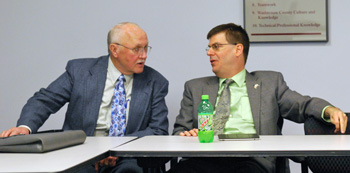No Decision Yet on County Redistricting
Washtenaw County apportionment commission meeting (May 4, 2011): With a June 6 deadline in sight, the group charged with adopting a redistricting plan for the county board of commissioners met again this week, but did not vote to adopt either of the two plans presented. Redistricting occurs every 10 years, based on population changes determined by the U.S. census.

Cleveland Chandler, chair of the Washtenaw County Democratic Party, and county treasurer Catherine McClary look at proposed redistricting plans before the start of the May 4 apportionment commission meeting. Both serve on the five-member commission.
There are currently 11 districts represented on the board of commissioners, including four in Ann Arbor. A 12-district plan was presented last month by county clerk Larry Kestenbaum, a Democrat who chairs the apportionment commission, and Mark Boonstra, a commission member and chair of the Washtenaw County Republican Committee. This plan – which would create a new district for Scio Township, but keep many elements of the current districts intact – was tweaked slightly by Kestenbaum since the last meeting.
A second plan, submitted by county prosecuting attorney Brian Mackie, drops the number of districts to nine. It would reduce the number of Ann Arbor districts from four to three, and put two current commissioners – Republican Alicia Ping of District 3, who lives in Saline, and Democrat Wes Prater of District 4, a York Township resident – in the same district. There were no changes to this plan since it was presented last month.
So far, no plans have been submitted by the public or by two other members of the commission: Cleveland Chandler, chair of the Washtenaw County Democratic Party, and county treasurer Catherine McClary. Chandler has previously expressed tentative support for the 12-district plan.
On Wednesday, McClary indicated that she’d like to see plans developed for eight and 10 districts. Mackie urged anyone who intends to submit plans to do it as quickly as possible, and to provide the plans to the commission in advance of their next meeting. The apportionment commission has scheduled another meeting for Wednesday, May 11 at 5:30 p.m. in the lower-level conference room at 200 N. Main St., Ann Arbor.
[For additional information about the redistricting process, see Chronicle coverage: "County Board Districts Likely to Change," "Public Gives Input on County Redistricting," "Washtenaw Redistricting Work Begins" and "County Clerk Outlines Redistricting Process"]
Two Plans – And More to Come?
At Wednesday’s meeting, two plans were again presented. A nine-district plan proposed by Brian Mackie was unchanged from the previous meeting on April 28. It would reduce the number of Ann Arbor districts from four to three, and put two current commissioners – Republican Alicia Ping of District 3, who lives in Saline, and Democrat Wes Prater of District 4, a York Township resident – in the same district. [.pdf file of nine-district map]
The 12-district plan – proposed by Larry Kestenbaum and Mark Boonstra – had been revised slightly by Kestenbaum since the last meeting. The plan creates a new district for Scio Township, but keeps four seats on the board for Ann Arbor. [.pdf of revised 12-district map] [.pdf map of original 12-district plan]
Kestenbaum briefly described the revisions he’d made. They include:
- Using M-14 as the northern boundary for the northwest district in Ann Arbor. Previously, that district included some areas north of M-14.
- Changing the boundaries for a split of York Township, which is part of two districts.
- Shifting a parcel that was previously “precariously connected” to the new Scio Township district. The new plan calls for that parcel to be included in the southern district of Ann Arbor.
- Eliminating a split of Pittsfield Township.

From left: Larry Kestenbaum, Mark Boonstra and Brian Mackie, three of the five members of the Washtenaw County apportionment commission, look at a proposed 12-district map. It had been originally drawn by Kestenbaum, revised by Boonstra, then revised again by Kestenbaum.
The overall maximum population variance for the 12-district plan is 7.92%. That’s slightly higher than the overall 6.48% variance of the nine-district plan. Both are within the allowable 11.9% variance set by the U.S. Supreme Court in the 1971 case of Abate v. Mundt. While the goal is to create districts with roughly equal population, the court ruled that there can be up to an 11.9% variance from that “ideal” population.
Boonstra said he wanted time to review the revisions. His initial impression was that the changes didn’t address the issue of township islands within the city of Ann Arbor. There may be a mechanism to resolve that in a better way, he said, and he wanted to think it through. Boonstra also noted that the plan included a split precinct in York Township.
Kestenbaum said he understood there was some interest in exploring other plans – possibly for 8, 9, 10 or 12 districts. McClary had requested that the commission not vote on a plan that evening, he said, adding that he agreed.
Mackie asked for details on other plans. “If people are going to submit plans, I’d hope they’d do it fairly soon,” he said.
Mackie noted that the apportionment commission has another meeting scheduled on May 11, and he hoped they could adopt a plan at that time. And if there are other plans to consider, he urged that they be distributed well in advance of the next meeting. He asked who has expressed interest in submitting other plans.
Kestenbaum then turned to McClary, who said that people have talked to her about those different district sizes. There are two things that are important for her, she said. One relates to student neighborhoods – a speaker during public commentary at a previous meeting had mentioned the importance of not splitting up university neighborhoods into different districts.
[That speaker was Yousef Rahbi, a current county commissioner representing District 11 in Ann Arbor, who addressed the apportionment commission at their April 28 meeting. He wanted to avoid a redistricting that would result in the kind of pie-shaped wards created for Ann Arbor city council, which split student neighborhoods into different wards.]
McClary said it’s difficult when student housing around the University of Michigan north campus, medical campus, and central campus are in different districts.
McClary said she was also concerned about the township islands. She noted that some township islands aren’t populated at this point – and if someone eventually moves onto those parcels, they’ll be required to be annexed into the city, she said.
[The issue of how to handle township islands has emerged at each of the apportionment commission's meetings. Because districts must consist of contiguous parcels, it's not possible to include all township islands in the same district. According to city of Ann Arbor planning staff, there are roughly 560 township properties located within the city. Most of the parcels are single- or two-family residential properties, or are vacant lots. The large majority are in Ann Arbor Township, followed by Scio Township, with a handful left in Pittsfield Township.]
McClary said that Kestenbaum has been very persuasive in arguing that because Ann Arbor is roughly a third of the county’s total population, the total number of districts should be divisible by three – with Ann Arbor getting a third of the seats. But if you take a broader view, she said, and try to keep the townships intact, then that rule no longer applies. McClary said she’s been told that eight or 10 districts could work well, and she wanted to look at that.
Kestenbaum said that as much as he’s concerned with keeping precincts whole, another priority – based on the state statute and case law governing redistricting – is to keep cities and townships in separate districts, as much as possible.
But Boonstra noted that in some cases, certain parts of townships have more in common with adjacent cities. For example, the southern part of Superior Township is more similar to the neighboring city of Ypsilanti than it is to the rural northern part of the township, he said. Kestenbaum acknowledged that there are differences between rural and urban parts of a township.
Public Commentary
Far fewer people attended Wednesday’s meeting than have turned out for previous sessions. Only two people spoke during the two opportunities for public commentary.

Current county commissoners Wes Prater (D-District 4) and Dan Smith (R-District 2) attended Wednesday's meeting. They've been regulars at the apportionment commission meetings.
Dick DeLong, a former county commissioner and current trustee in Scio Township, said he was quite impressed with the 12-district plan. It takes them back to 1992, he said, when most of Scio was in the same district. The nine-district plan is also appealing, he said, but with only nine commissioners, the districts are too large. He preferred 12 districts. DeLong also praised anyone who could come up with a plan – he had tried, he said, but wasn’t able to do it.
Wes Prater, a current commissioner representing District 4, said he was initially skeptical of an even number of districts. But the more he’s thought about it, the more he likes it. It would take seven votes to pass a resolution, but only six to stop it, he said: “I think that’s really kind of intriguing.”
Public Commentary: Commissioner Response
Kestenbaum noted that when he served on the Ingham County board of commissioners in 1980, there were 20 members – the even number wasn’t a problem, he said. [At a February 2011 working session of the Washtenaw County board of commissioners, Kestenbaum expressed a preference for an odd number. From Chronicle coverage: "Kestenbaum said he didn’t think it would be politically viable to talk about an increase in the number of commissioners. He thought that having 5, 7, 9 or 11 districts would be the likely choices, noting that an uneven number is preferable."]
Next Steps
It’s unclear whether more plans will be submitted. Julia Roberts, who was hired as temporary support staff for the apportionment commission and who helped put together the two current proposals, is no longer working in that job. Kestenbaum said Roberts has left instructions for operating the mapping software – DISTRICTSolv – used to generate the district maps, but it’s definitely more challenging to do that without her help.
Based on Wednesday’s discussion, it seems as though McClary is the only commissioner who might be submitting additional proposals. Chandler had previously expressed support for the 12-district plan submitted by Kestenbaum and Boonstra.
The commission’s next meeting is set for Wednesday, May 11 at 5:30 p.m. in the lower-level conference room at 200 N. Main St., Ann Arbor. If the commission does not vote to approve a redistricting plan at that time, they’ll likely schedule an additional meeting. By law, they must approve a plan within 60 days after block-by-block census data is released. That deadline is June 6.




The meeting is at 5:30 pm today, in the lower level meeting room at 200 N. Main, Ann Arbor.
Six plans have been presented, and all six are already posted on the wall of that room. Everyone is invited to come and examine them, starting now. The plans are lettered A (5 districts), B (6 districts), C (9 districts), D (9 districts), E (12 districts), and F (21 districts).
If there are any other plans being proposed, I have not seen them.
We hope to wrap up this process today.
Four additional plans were just submitted by Mr. Boonstra: an 8-district plan, a 9-district plan, a 10-district plan, and an 11-district plan. These will be posted in the room as soon as I get them printed up.